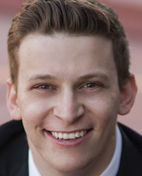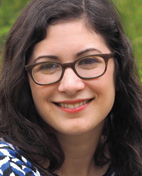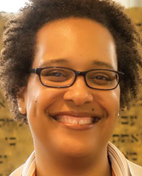lives
THREEPROFILES |
In this issue, we visit three
|

“Richard Tucker, who was a hazzan as well as an opera singer, talked about the musicality and artistic freedom you have as a hazzan — this material that you have to phrase and connect.” |
ARYEH NUSSBAUM COHENSong from Shul to Stage‘‘Met Opera Auditions Yield a Young Star,” declared an article in The New York Times that changed the opera singer Aryeh Nussbaum Cohen’s life and career. He was only 23-years-old when in March, 2017, the Times’s classical music editor Zachary Woolfe deemed Cohen — the “baby-faced countertenor from Brooklyn” — to be a “complete artist.” Cohen, Woolfe wrote, “already possesses a remarkable gift for intimate communication … combined with a voice of velvety gentleness and a taste for adventure.” “My life changed overnight,” said Cohen (the son of journalist Debra Nussbaum Cohen, who currently serves as Haaretz’s New York correspondent) of the glowing review. He had had a good season up until then, having been one of the winners of the Metropolitan Opera National Council Auditions, a program designed to discover promising young opera singers and assist in the development of their careers. But to have that kind of notice in the paper of record, Cohen added, “provided a level of exposure throughout the industry that you can’t buy — that you can only dream of.” When CONTACT caught up with Cohen, it was over the phone from Cincinnati, where at the time he was preparing to take on the role of Ottone in Claudio Monteverdi’s The Coronation of Poppea. “It’s considered the first masterpiece ever written,” Cohen said. At the center of the opera is a love triangle involving the titular Poppea, the Emperor Nero, and the spurned Ottone. While a history major at Princeton, from which he graduated in 2015, Cohen sang in The Coronation of Poppea, playing the part of Nero. “It’s a show I’ve known intimately for a number of years and am delighted to be revisiting from another angle,” he said. His remarkable rise and journey to the opera houses of Europe and the United States began in Brooklyn: in the Brooklyn Youth Chorus, which rehearsed a block away from the Hannah Senesh Community Day School he attended; and later, beginning at aged13, as a trainee cantor at the Conservative East Midwood Jewish Center. Cohen concedes that it was “a lot of work” learning the High Holiday liturgy and doing the afternoon prayers every day, among his other duties, but that under the stewardship of Cantor Samuel Levine he “learned a lot artistically” that could be transferred from the shul to the stage. “One of the greatest singers of the 20th Century was the tenor Richard Tucker, who was a hazzan as well as an opera singer,” Cohen explained, “and he talked about the musicality and artistic freedom you have as a hazzan — this material that you have to phrase and connect.” During his seven years as a trainee cantor and afterwards, Cohen began to appreciate more and more the heritage and the lineage associated with the material he was singing — songs and melodies “passed down through the Jewish people over thousands of years. I found that very moving.” Cohen has become distinguished for his countertenor voice. The countertenor has a higher range than a male tenor, comparable to a female contralto or mezzo-soprano. Since the mid-20th Century, there has been renewed interest in this particular singing voice, and modern composers are once again writing countertenor roles. “My favorite compliment that I sometimes get is, ‘I’ve always hated countertenors but I actually like your singing,’” Cohen laughed. It’s a backhanded compliment — “but I’ll take it! I strive for a warmth in my voice — the kind a mezzo-soprano would have — so it’s always fun when someone says that.” The forthcoming season has much in store for Cohen. He will be based in San Francisco, continuing his training with the San Francisco Opera as an Adler Fellow. He also has a number of concert engagements and will be recording his first album. But perhaps the role he is most excited about is that of King David in the Philharmonia Baroque Orchestra & Chorale’s new production of George Frideric Handel’s oratorio Saul, which they will be performing in San Francisco as well as at the Walt Disney Concert Hall in Los Angeles. Saul begins just as David has killed Goliath. “It’s about David’s rise and Saul’s descent into madness, as the adulation of David takes over the Hebrews. What I think is so fascinating about the way Handel writes it,” Cohen explained, “is that it’s very much based on the Biblical text, but he delves into things that are more controversial by today’s standards,” such as David’s relationship with Jonathan. “The music Handel writes when the news comes to David that Jonathan has been killed is the most stunning lament. Musically, it is clear how much this means to David. The depth of emotion is extraordinary.” Cohen feels he is fortunate in that a great many countertenor roles are to be found in oratorio, which typically drew on Biblical stories as their source material. David is “a character I have a strong Jewish connection to,” he concluded, “and it’s an amazing piece.” ■ |

|
SHARI RABINFrontiers of Jewish Life‘‘When I was in graduate school, I thought I would be working on post-Second World War American Jewish history,” the historian and author Shari Rabin told me, when I asked about the origins of her award-winning debut book, Jews on the Frontier: Religion and Mobility in Nineteenth-Century America (NYU Press, 2017), about how Jews forged their own religious culture on the American frontier. “And then I took a class on religion in the American West, which focused a lot on the 19th Century. Working on a paper for that class, stumbling around in the library, I found Isaac Mayer Wise’s letters that he wrote from a trip to San Francisco in 1877.” And thus the journey began. Isaac Mayer Wise, the eminent American rabbi of the 19th Century who founded not only the Reform Union of American Hebrew Congregations in 1873 but also Hebrew Union College in 1875, “is very well-known in American Jewish history,” Rabin said. But in these letters, Rabin explained she found another Wise. “It’s him speaking in a casual, upbeat voice — very different than what you see in his sermons and editorials. He’s describing going west, all the Jews he’s meeting along the way, and it just seemed to be something different than what I had read about.” A lot of the work on 19th-Century Jewish history that Rabin had encountered up until that point “was just about the rise of Reform Judaism, and it was very synagogue-based. You didn’t get the texture of Jews living in these far-flung places” — for example, life on the American frontier, which is the subject of Rabin’s book. Breaking out of the Lower East Side-centric view of American Jewish history, Rabin thought there was something more to say. “It’s not just that everybody was in a synagogue, deciding whether or not to embrace Reform Judaism.” So Rabin asked herself: Who are these people that Mayer Wise is meeting? What’s going on with them? And how is Mayer Wise responding to these Jews he’s encountering? Rabin grew up in Shorewood, Wisconsin, and Marietta, Georgia before majoring in religion at Boston University. She received her Ph.D. in religious studies from Yale University in 2015, thereafter joining the Yaschik/Arnold Jewish Studies Program at the College of Charleston in South Carolina. Today, she is Assistant Professor of Jewish studies there and Director of the Pearlstine/Lipov Center for Southern Jewish Culture. Jews on the Frontier, her first book, won the National Jewish Book Award in 2017 in the American Jewish Studies category, and was a finalist for the Sami Rohr Prize for Jewish Literature in 2018. “I felt like I was discovering a whole century of American Jewish life that was really rich and important that had barely been touched — the surface had barely been scratched,” Rabin said. In Jews on the Frontier, she recounts the journey of Jews who ventured into the American West and South during the 19th Century. Communities began to emerge informally, constantly evolving and inherently unstable, and the book tracks the successes and obstacles Jews encountered as they sought to take advantage of new economic opportunities and the challenges and complications this migration imposed upon traditional Jewish life. Central to Jews on the Frontier is the idea that mobility shaped Jewish life on the frontier. B’nai B’rith fraternal lodges and Jewish newspapers were arguably more important than synagogues as a means of connecting Jews transiting from town to town. “You could be the only Jew in your town [and] still subscribe to the Jewish newspaper,” Rabin explained. The work of Wise was in part about creating a national framework for Jews in the United States, “but their top-down efforts were limited in their success” in the West, Rabin said. On some level, “the Jews in those communities liked being able to create the Judaism that was suited to their particular congregation and location. They didn’t want some rabbi or institution telling them what to do.” At the same time, the inherently Protestant idea of Manifest Destiny and the expansion across and conquest of the American West became one of the means by which Jews became integrated into the American story. Rabin found that Jews took on the language associated with Manifest Destiny, internalizing it in order to talk about American Judaism itself and its spread across the continent. Although there were cases of anti-Semitism here and there, “mobility and movement was one of the ways that Jews expressed their whiteness” in the 19th Century, Rabin said. As in the period captured in Jews on the Frontier, today Jewish communities across the country are experiencing tremendous change, and therefore Rabin believes her book also has a contemporary relevance. “American Jewish life has always been pragmatic and eclectic,” Rabin concludes. “There’s a lot of anxiety now about post-denominationalism and [disaffiliation], but if we look at this pre-denominational moment in the 19th Century, we can see that on some level that was always the case. Jews have always pieced together their religious lives — it’s baked into American life. Jews seek out Jewish identities, practices, and ideas when they are meaningful and help them make sense of their lives.” ■ |

|
RABBI GEORGETTE KENNEBRAEThe Pastoral ChaplaincyThis year, the Reconstructionist West End Synagogue on the Upper West Side welcomed a new spiritual leader: Rabbi Georgette Kennebrae, who graduated from the Reconstructionist Rabbinical College in 2017. She arrives at the West End Synagogue — having previously served as a rabbinic intern at Congregation Beit Simchat Torah, the Reconstructionist Synagogue of the North Shore on Long Island, and Bristol Jewish Center in Pennsylvania — at a time of tremendous change for the Reconstructionist Movement. Kennebrae was born in Japan into a military family and had a transitory childhood, living in Turkey and France as well as various cities in the United States after her father left the air force and went to work for Boeing. She told me it was an experience she loved, and she believes there is a connection between her childhood of constantly meeting new people and becoming immersed in other languages and cultures and her life and work today at the West End Synagogue. “I feel very comfortable creating spaces of welcome and inclusion for other people because I’ve known what it’s like to have that and do not have that,” she contemplated. “It makes me grateful for the time a community has together.” A graduate of the University of Oklahoma and Brandeis University, Kennebrae had chapters in her life as a stay-at-home mother, followed by a career in higher education at the University of Denver, before finding her way to the Reconstructionist Rabbinical College. In addition to being born into a military family, she was later a military spouse herself. Kennebrae told CONTACT that it was during this time that she discovered the importance of chaplaincy, which set her life on a new trajectory — one which led to the rabbinate. She had fallen in love with the practice of leading services, providing pastoral care, and being part of congregational life. “I think of myself as a pastoral rabbi, in that the pastoral chaplaincy is core to everything that I do. I think people want to be seen and heard, supported and celebrated, and when I can do that — and do it well — then it allows people to flourish and be who they are and grow,” Kennebrae explained. “I love that, as a rabbi, I get to support my community in times of joy and periods of pain. I have a passion for death and dying — conversation, education, advocacy, awareness — and one of the reasons that I do is that I deeply believe that when one is willing to address one’s mortality and prepare for it, they can make space to live life more fully.” It was in Colorado that Kennebrae become more involved with Reconstructionism, having discovered that the movement — with its civilizational approach that “honors the evolution of religion” and recognizes that “halacha has a vote but not a veto” — sat in alignment with her beliefs and practices. “One of the things I really love about Reconstructionism is that the umbrella is really large,” Kennebrae explained, “and people can show up fully, ask whichever questions they want, and find a way in their community to have meaningful Jewish practice.” The movement itself has undertaken important changes in recent years, both structurally and philosophically. The Reconstructionist Rabbinical College and Jewish Reconstructionist Communities rebranded earlier in the year as Reconstructing Judaism. In 2015, meanwhile, the rabbinical college voted to accept students who are in interfaith relationships, making Reconstructionist Judaism the first stream in the United States to officially allow rabbis in relationships with non-Jewish partners. Kennebrae sees these changes as necessary to help individuals and communities remain engaged with Judaism in a way that “celebrates the diversity of the Jewish community.” Jewish and American civilizations are not static, she said, and the ability to remain fully Jewish while embracing other aspects of one’s identity is incredibly important. “A lot of harm has been done and there are people in a lot of pain who have felt rejected from Judaism because of lines in the sand that have ultimately hurt Jewish communities, families, and individuals’ ability to remain engaged,” Kennebrae concluded. “There are a lot of spaces in the world in which one cannot bring one’s full self,” she said. “To make synagogues meaningful, people need to not be afraid to bring the things that they’re afraid of, the things they’re struggling with, or the things that are considered ‘taboo’ to talk about.” At the West End Synagogue, Kennebrae talks about this regularly from the bimah; these ideas of openness, inclusivity, and fearlessness are some of the values she believes her community embodies. “I’m fully committed to celebrating the diversity of Judaism and Jewish peoplehood,” she said. “People come [to the West End Synagogue] and don’t have to worry about what I look like, what race am I, what is my sexuality, am I wealthy, am I poor. I want people to show up and know that they have gifts to offer.” ■ |
Liam Hoare is a contributor to Moment and writes frequently for The Forward, Tablet, and Slate. He is based in the United Kingdom and is a graduate of University College London’s School of Slavonic and East European Studies.
| PREVIOUS ARTICLE | NEXT ARTICLE |